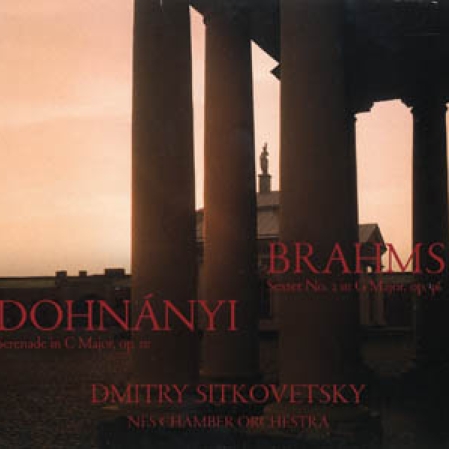Russian-born violinist Dmitry Sitkovetsky, whose art of transcription was featured on his previous Nonesuch recording of Bach’s Goldberg Variations for strings, turns his attention to Hungarian composer Ernst von Dohnányi's Serenade in C Major, which underwent a major transformation for chamber orchestra, and Brahms’ String Sextet no. 2 in G Major.
The CD of this album is available to purchase at ArkivMusic.
The Russian-born violinist Dmitry Sitkovetsky, who founded the New European Strings Chamber Orchestra in 1990, has enthusiastically practiced the art of transcription for many years, producing more than 25 new string arrangements of chamber and keyboard works. Sitkovetsky’s first project for Nonesuch, a creative adaptation of Bach’s Goldberg Variations for strings, cast a fresh light on that formidable monument of keyboard music. The New York Times called it “robust, joyous and full of insight."
The abundance of superbly-trained string players in Russia, the longstanding Russian tradition of encouraging such ensembles, and Sitkovetsky’s great interest in studying orchestration led him to found the NES Chamber Orchestra, who proved to be ideal interpreters. The New Yorker, in a review of the Goldberg Variations recording, said: “[T]he New European Strings Chamber Orchestra combines interpretive insight with exemplary playing; even suspicious purists will hear contrapuntal felicities that keyboard players can only suggest.” Sitkovetsky has referred to the orchestrations of Mahler and Schoenberg in particular as “a way to study music, to hear it in a new way, to make it your own,” and set out to arrange a pillar of the repertoire, which in turn showcased his talent as arranger, conductor and leader. One of his first attempts at transcription was the Serenade in C Major, op. 10, by Hungarian composer Ernst von Dohnányi (1877-1960). Originally composed for trio in 1902 and expanded by Sitkovetsky for the debut of his orchestra, the transcription follows the typical serenade form of five or more short movements (in this case five), beginning with a march and ending here in a Haydn-esque rondo. Other early Sitkovetsky transcriptions include Shostakovich’s String Quartet No. 3, and Tchaikovsky’s Souvenir de Florence. More recently Sitkovetsky transcribed Brahms’ String Sextet no. 2 in G Major, op. 36 (1864-65). While the Dohnányi Serenade underwent a major transformation to reconcile the large forces of his ensemble with the original trio version, the Brahms transcription needed very few modifications in order to accommodate an ensemble a little over twice the size of the sextet for which it was originally intended.
MUSICIANS
New European Strings Chamber Orchestra
Dmitry Sitkovetsky, conductor
Ilya Kaler, concertmaster
Victor Demovski, Noëmi Bodden, Joakim Wendel, Corina Belcea, first violin
Mikail Rappoport, principal second violin
Alexander Baev, Yuri Zhislin, Padraic Savage, Faina Machtina, second violin
Ron Ephrat, principal viola
Valentin Slobodeniuk, Elena Iakovleva, Vitaly Sitkovetsky, viola
David Tonkonogui, principal cello
Vladimir Chevel, Mimi Sunnerstam, Miriam Finkelstein, cello
Boris Kozlov, bass
PRODUCTION CREDITS
Produced by Dmitry Sitkovetsky and Heinz Wildhagen
Recorded July 14-16, 1997, at Reitstadel Neumarkt, Germany
Engineered by Heinz Wildhagen
Serenade in C Major written by Ernst von Dohnányi; Sextet No. 2 in G Major written by Johannes Brahms
Design by Henrietta Condak
Photograph by Joel Meyerowitz
79545
MUSICIANS
New European Strings Chamber Orchestra
Dmitry Sitkovetsky, conductor
Ilya Kaler, concertmaster
Victor Demovski, Noëmi Bodden, Joakim Wendel, Corina Belcea, first violin
Mikail Rappoport, principal second violin
Alexander Baev, Yuri Zhislin, Padraic Savage, Faina Machtina, second violin
Ron Ephrat, principal viola
Valentin Slobodeniuk, Elena Iakovleva, Vitaly Sitkovetsky, viola
David Tonkonogui, principal cello
Vladimir Chevel, Mimi Sunnerstam, Miriam Finkelstein, cello
Boris Kozlov, bass




